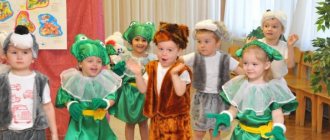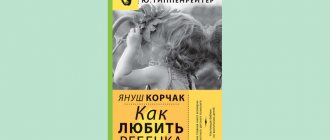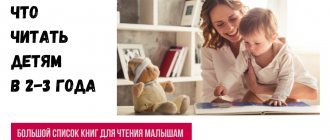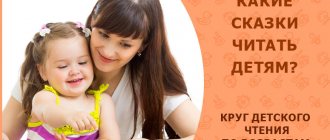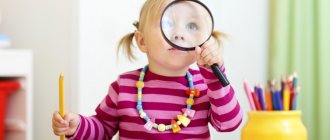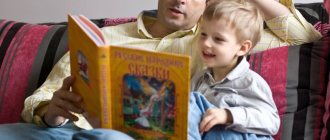Objectives of fiction in the middle group
Preschool institutions devote a special place to reading fiction. Based on the federal state standard, this activity is separated into a separate educational part. She pursues her goals and objectives. These tasks become more complex as the child grows older.
Important! New generations are required to read more than others in order to navigate the flow of information well.
Reading fiction develops thinking and speech
The main purpose of reading to children in the middle group is to develop a comprehensive personality and instill a love of reading. Its tasks are:
- development of experience in listening to works of various genres of folklore (jokes, riddles, fairy tales, etc.), prose (fairy tales and short stories), poetry (poems, fairy tales in verse);
- arousing interest in literary works, instilling a love for constant communication with books with an adult and independently;
- develop the ability to listen and perceive text. The child must understand the main meaning of the text, be able to restore cause-and-effect relationships, be able to characterize the characters of the work, and evaluate their actions;
- develop artistic and speech activity. This is achieved by retelling, expressively telling by heart jokes, poems, nursery rhymes;
- development of skills to compose poetic rhymes and descriptive stories;
- maintaining the child’s desire to express his impressions of the piece he heard. This can be done in the form of a drawing, a game of making figurines.
Children need to be instilled with a love of reading from childhood.
The objectives listed above are educational. In addition to them, there are educational and developmental tasks.
Developmental functions include:
- development of ideas about the natural world;
- speech development based on language norms;
- development of grammatical and lexical skills before the child goes to school;
- development of skills to see beauty.
Among the educational tasks the following stand out:
- formation of ideas about moral standards of behavior;
- formation of positive qualities (kindness, honesty, generosity, etc.);
- the formation of a negative attitude towards bad qualities (lies, envy, etc.).
Reading serves several purposes at once
In the fourth year of life, the child’s perception of fiction is still superficial. He is able to identify only the simplest connections between ongoing events. His attention is focused on one main character and two or three minor ones. He cannot evaluate their actions without understanding the motives for their behavior.
Fiction is perceived differently in the fifth year of life. The child begins to wonder why someone did what they did and what followed. The child is already trying to establish cause-and-effect relationships.
Important! In the fifth year of life, the child begins a different stage of perception of works of art. He shows interest in them and tries to understand the deeper meaning.
Educational purpose
The junior group of kindergarten does not focus on educational goals; the middle group begins to focus on them. Reading fiction, in addition to its self-evident entertainment function, should have as its goal the intellectual development of the child.
The perception of the plot itself is a colossal intellectual task for children of this age. The teacher must monitor how well children grasp logical and - especially - cause-and-effect relationships.
In the event that a teacher notices the inability of individual children to understand the meaning of the text, this should be a reason to understand the reasons. If in some cases this may be evidence of pedagogical neglect and some lag due to insufficient attention to the child from the parents, then in other cases it may be a signal of the child’s developmental characteristics. If a child, who is surrounded by the attention and care of his parents, is not able, unlike others, to answer basic questions about cause-and-effect relationships, this may be a reason to contact a psychologist.
Perception of literature in the middle group
The perception of a work of art is understood as a process that involves active activity, embodied in internal assistance, empathy for characters, and transference of events to oneself. As a result, the child feels that he is personally involved in the events taking place.
The development of perception of works goes through several stages:
- direct perception;
- empathy with the images of the work;
- the influence of literature is available.
The book arouses interest in the child at an early age. He likes to flip through pages, listen to adults read, and look at pictures. If the necessary work is carried out, then already in the third year of life the child may be interested in the fate of the heroes.
Important! The main feature of a child’s perception of a literary work is empathy for the characters.
Breathing exercises for children in preschool educational institutions
Perception is an active process. The child begins to put himself in the place of the heroes, takes some mental actions and fights with enemies. Another feature of children's perception was also noted: the child does not like it when a work ends badly.
In middle preschool age, turning points occur in understanding text. This is due to the fact that life and literary experience is expanding. The child is able to establish the simplest connections in the plot. He can correctly assess the actions of the heroes. Children react to the word and show interest in it. They strive to comprehend and beat it. At this age, not only the content of the work is perceived, but also the features of the language. When the text is read, the child is able to answer questions about the text. He can think, reflect and analyze.
The main feature of a child’s perception of a work is empathy for the characters.
Preparing to perceive texts of a different level
We must not forget that the child has a senior and preparatory group ahead of him. Reading fiction should dynamically prepare him for the tasks that are posed at this age. The older a child becomes, the more serious the problems that he may encounter in his education, the more noticeable are the omissions that occurred in the initial stages of his life.
At school, the basic method of teaching is learning through text (spoken by the teacher or read in a textbook). The ability to perceive text as such and the ability to extract information from it “artificially” is formed rather long and difficult, with great resistance on the part of the child.
This ability develops unobtrusively and easily in those children who have been accustomed to listening to literary texts since childhood. Many parents who are late in developing this ability and begin reading to their children only before school note that children either perceive the text with great stress, or sabotage such activities, or simply fall asleep. This is understandable, since it is quite difficult to perceive text without habit. Literature that is read and perceived by ear should “grow” with the child and begin not with lengthy stories and textbooks, but with short poems and stories, adapted fairy tales.
The importance of reading before bed
The importance of reading to your child before bed is as follows:
- going to bed is the best time to read. Here you need to choose the best moment when the child is ready to listen. If you make reading a daily ritual, even a restless baby will look forward to being read a bedtime story;
- the child's mood improves. Reading helps calm a child. He forgets everything that happened during the day and his mood improves. In order not to spoil it, it is better to select fairy tales that have a good ending;
- positive impact on character formation. By devoting just 20 minutes a day to reading before bed, the child becomes more obedient and attentive;
- mental abilities develop. During the reading process, the child has questions about unclear words or about the plot. In this regard, evening reading will develop his vocabulary, imagination and thinking;
- exploring the world. Thanks to fairy tales and stories, children learn what good and evil, friendship, love, hatred, selfishness are;
- the opportunity to raise a child with the help of fairy tales. The good deeds of heroes can be an example for a child;
- getting closer to the child. A connection between a child and an adult can be established through reading before bed. If a child asks to read the same book, it means he is interested in something in it.
Reading before bed is a good tradition
Reading before bed should become a good tradition. With its help you can instill a love for books.
Development of imagination and spiritual basis
Reading fiction in preschool educational institutions, of course, plays an important role in the development of imagination. A common misconception of many parents - and educators - is the idea of this ability as optional. Meanwhile, this is one of the basic (if not primary) intellectual and spiritual functions. Suffice it to say that the ability to imagine and imagine is a diagnostic criterion for identifying a number of mental disorders, including clinical mental retardation and autism. Excessive development of one's own fantasies and the inability to focus on the artistic world created by another person may be a signal of the development of schizophrenia.
The ability to imagine is the key to the development of abstract, independent thinking, the ability to solve problems not according to the model, find answers to everyday questions and life difficulties, and cope with new responsibilities. The development of imagination allows a person to be independent both in elementary and spiritual terms - in personal relationships, political views, aesthetic tastes and religious beliefs. A person with a critically poorly developed imagination will always be distinguished from others by lack of control, helplessness and dependence.
Methodology for developing and conducting CHL classes
There are various programs and notes for reading in kindergarten. Among the main methods for conducting classes in CHL are:
- The teacher reads a book or recites a story by heart. If the reader tells by heart, then he must preserve the author’s language and convey all his thoughts. A significant part of the works is read from a book;
- the teacher says something. Here the text is transmitted in free form;
- staging - secondary acquaintance with the work;
- learning by heart.
Important! Work with a book in kindergarten can be carried out in the following forms: the work is read and told, or works of oral folk art and poems are memorized.
Reading activities can be divided into several types:
- one work is read or told;
- Several works are read or narrated that have a common theme. For example, reading stories about spring. It is possible to combine works of one genre or several genres;
- works that belong to different types of art are combined into one lesson. For example, one reads a work and then looks at a painting by a famous artist that is associated with that work. It is also possible to read in combination with a piece of music. When conducting such activities, it is necessary to take into account the strength of the impact on children’s emotions. It is also necessary to take into account the responsiveness of children and their culture of behavior;
- reading is done using visual material. Such material can be: toys (for example, reading the tale of the three bears can be accompanied by a display of bear toys), a tabletop theater (it can be made of cardboard or plywood), a puppet theater, a display of filmstrips and films;
- Reading is an activity for speech development. It can be included in the content of the lesson itself, or it can be an independent lesson.
A long-term lesson plan to familiarize yourself with the world around you
To conduct a lesson, preparation for it is required. To do this, the following steps are carried out:
- Select a work taking into account the required criteria, taking into account the age of the children, the time of year and the method of working with the book.
- Determine the work plan. Set literary and educational goals.
- Prepare for reading. The teacher should read the work like this. So that children understand its basic meaning and idea. To do this, it is necessary to analyze the text, understand what the author was trying to convey, the character of the characters, their relationships and motives for their actions.
- Work on the expressiveness of text transmission. To do this, it is necessary to work out ways of expressing emotions (tone and intonation), correctly place stress and pauses, work on diction and correct pronunciation.
- Prepare the children. Expand their understanding of the world through excursions, studying paintings and illustrations.
How to conduct interesting activities
To make the lesson truly interesting for children, you need to create a fairly bright and emotional atmosphere. There should be a lot of color pictures and things around that will help children and set them up for a fairy tale. Seeing a toy with Ivanushka the Fool, children will be able to understand what fairy tale they will be watching today. They will immediately guess what will be discussed in the lesson. This is also required by the Russian Federal State Educational Standard. The activity should be lively and active. Children must talk, draw and show.
On a note! There should be many different games. Don't dwell on one for too long. In this case, children will quickly lose interest in what is happening.
Performances based on stories
Productions based on fairy tales can be divided into 2 types:
- Real. The teacher reads the work. Then the roles are handed out, and the children must remember what their heroes said. Such a dramatization trains memory, oral speech and logic of statements. For example, what the little goat and the little fox were talking about.
- Fictional. You can make a production based on any fairy tale. In addition, you can organize a meeting of different heroes from different fairy tales. For example, what would seven little goats and a cockerel talk about? Many children will enjoy the game about fairy-tale characters who ended up in their group. The kids will be able to talk to their favorite characters. In return, these characters will be able to share their experiences with children.
Productions based on fairy tales
Play activity
Since the main type of activity for children is play, preschool teachers should rely on this activity. Games will help you learn everything faster, and the learning itself will be much more fun. In general, there are a large number of different games. For example, "Dropped Frame". This game helps develop monologue speech.
Drawing “Icicles are crying” - spring theme for younger groups
At the same time, memory is trained. In this game you need to create a plot based on a series of pictures. One picture is removed. The child needs to understand what happened on the removed card and tell about it. There is a game called "Show Me". The child shows and talks about some fairy tale hero. The others are trying to guess who it is.
Games based on fairy tales
Card index with goals for the middle group of the Federal State Educational Standard
Next, we consider reading fiction in the middle group of cards with goals for 3 months.
Month January
You can build a plan for studying fiction as follows:
- The goal of the first week is to teach children to recite poems by heart, develop imagination, speech, and develop listening skills. The theme of the week could be winter. All works must be related to winter (for example, S. Yesenin’s poem “Winter Sings, Calls...”);
- The topic of the second week: family. Goals: instilling interest in reading, developing the ability to answer questions, enriching vocabulary. Here you can read such works as: K. Chukovsky “I am my mother’s only son”, K. Ushinsky “Cockerel with his family”.
- The third week's topic is about animals. Goal: instilling a love for Russian folk tales, enriching vocabulary, developing expressive speech. This block can include such works as the fairy tale “Turnip”, D. Mamin-Sibiryak “The Tale of the Brave Hare”, solving riddles, G. Oster “A Kitten named Woof”.
Month February
The lesson plan for February is as follows:
- Theme of the first week: getting to know birds. Goals: developing the ability to empathize with characters, fostering interest in reading, developing the ability to express one’s thoughts. The works may be as follows: A. Yashin “Feed the birds in winter”, M. Gorky “Sparrow”.
- The second week is dedicated to winter nature. Goals: developing interest in fairy tales and heroes, developing imagination. Here you can read: S. Kozlov “Winter's Tale”, poems about winter, L. Voronkova “Snowing”.
- The third week is dedicated to the defenders of the Motherland. Goals: introducing children to border guards, warriors who defend the Motherland. List of works: S. A. Marshak “Border Guards”, V. Borozdin “Starships”.
Month of March
March classes include the following:
- First week: March 8 - Women's Day. Goals: getting to know new poems, memorizing them, developing memory, nurturing love and respect for mother, broadening one’s horizons about spring. Works: V. Shugraev “To Mom”, E. Blaginina “Mom is sleeping, she is tired.”
- Second week: necessary items. Goals: introducing children to new works, developing auditory attention, developing the ability to answer questions. Works: A. Matutis “Look What a House”, A. Barto “The Lame Stool”.
- Third week: space. Goals: expanding children's ideas about space. Reading various stories about space, a fairy tale about the solar system by M. Hrdazhe.
Important ! In the autumn months it is worth devoting classes to studying autumn, in the summer - summer. Other relevant topics will be the study of professions, the process of sleep, and birth.
Fiction plays a huge role in the development of a child. It is important to instill a love of reading from early childhood.
Development of emotions
What makes a person human is the ability to sympathize, understand and predict someone else’s condition, the ability to “read” the feelings and thoughts of another. Any competent psychiatrist will confirm that these are not just lofty words, but indicators of a normally developing child. These abilities are impaired or not expressed in orphans, as well as in children with autism spectrum disorder. A lag in the ability to sympathize, a clearly poor emotional sphere – these are objectively abnormal (in the medical sense of the word) manifestations. For many children, this is evidence of pedagogical neglect.
Reading fiction in childhood can develop these abilities and provide the opportunity to obtain more complex emotions from books of a different level in the future.
Development of communication
The development of social skills and communication capabilities is one of the most important reasons (besides, of course, purely everyday reasons) why a child should attend kindergarten. Reading fiction is a great opportunity to develop communication skills. Discussing what they read with children gives them the opportunity not only to listen, but to express themselves. One of the signals that reading is going well is the flow of lively and immediate reactions to what you read, questions of a very different nature. Discussion of a work by children among themselves on their own initiative is the “aerobatics” of a teacher.
A book, as a reason for a child to talk with an adult or with other children, raises him to a new stage of mental and intellectual development.
